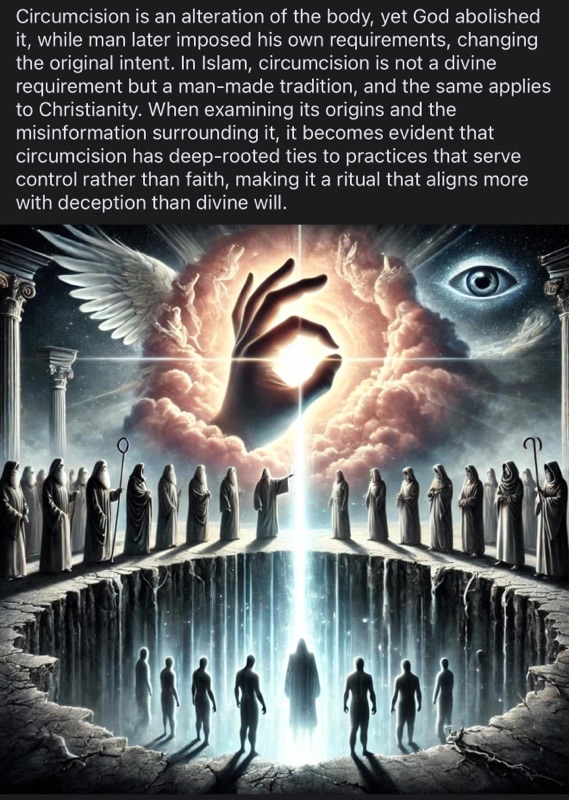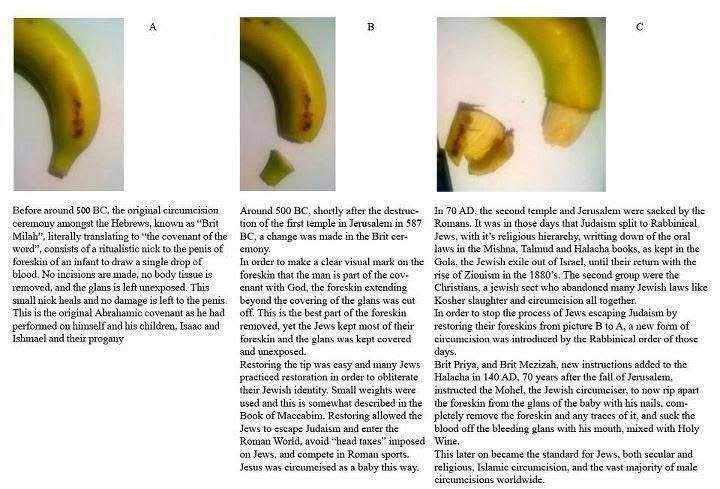The Circumcision Cover-Up: How Religious Leaders Changed the Original Practice
The Circumcision Cover-Up: How Religious Leaders Changed the Original Practice
The Evolution of Circumcision: From Ritual Marking to Full Foreskin Removal
Religious Misinformation: The Distortion of Circumcision’s Original Meaning
Written By ✌️💚🥑🍌 AvocadoJay23 | AdvocatingAvocado
(I had so many titles in mind to show about this Jewish history of circumcision, let’s explore a few before we dive into this blogs article:)
• The Truth About Circumcision: Was It Ever Meant to Cut the Penis?
• Circumcision in History: The Shift from Symbolic Bloodletting to Full Removal”
• Circumcision Was Never Meant to Cut the Penis—The Hidden Truth
The claim that circumcision was never originally intended to be performed on the penis is debated, but there is historical evidence suggesting that early forms of circumcision were much less invasive than the modern procedure. Here’s a breakdown of the origins, religious context, and historical transformations of circumcision:
Origins of Circumcision:
1. Ancient Egypt (~2400 BCE):
• Some of the earliest depictions of circumcision come from ancient Egyptian artwork. It appears to have been a rite of passage or a purification ritual for priests rather than a widespread practice.
• Egyptian circumcision was often partial, removing only a small part of the foreskin rather than the entire prepuce.
2. Ancient Semitic Tribes & Early Hebrews (~2000 BCE):
• The earliest Hebrew circumcision was described in the Old Testament (Genesis 17) as part of God’s covenant with Abraham.
• Some scholars argue that the original Hebrew word for circumcision (“mul”) may have referred to a minor incision or symbolic bloodletting rather than a complete removal of the foreskin.
Transformation of Circumcision Over Time
1. Biblical Circumcision (~2000 BCE - 500 BCE):
• Early Jewish circumcision likely involved only a small cut or partial removal of the foreskin, not full excision.
• There is no clear evidence that the entire foreskin was removed during the Abrahamic covenant in Genesis 17.
2. Hellenistic Influence (~300 BCE - 200 CE):
• During the Greek and Roman periods, Jewish men attempted to “reverse” circumcision (epispasm) to fit into Hellenistic society, which valued the intact male body.
• In response, rabbinic authorities modified circumcision to a more extreme version known as “periah,” which required full removal of the foreskin to prevent reversal.
3. Talmudic Era (200-500 CE):
• The Jewish Talmud (Shabbat 133a) established that circumcision must now include “periah,” meaning the full removal of the foreskin, not just a ritual cut.
• This change was explicitly made to prevent Jewish boys from being able to pass as uncircumcised in Greco-Roman society.
4. Medieval & Islamic Influence (~600-1500 CE):
• Islam also adopted circumcision (khitan), though the Quran does not command it.
• Different Islamic sects practice varying degrees of circumcision, from a minor cut to full removal.
5. Modern Medicalization (~19th-20th Century):
• Victorian doctors in the 1800s promoted circumcision as a “cure” for masturbation and various diseases.
• The practice was further institutionalized in the U.S. and other Western countries for hygiene and medical reasons, despite lacking scientific necessity.
Key Takeaways & Evidence
1. Original Circumcision May Have Been Symbolic or Minimal
• Early Semitic tribes likely practiced a small incision rather than full foreskin removal.
• The Talmudic ruling in the 2nd century CE forced full removal to make circumcision permanent and prevent “reversal.”
2. Rabbinic Authorities Changed Circumcision to Prevent “Reversal”
• Hellenized Jews in ancient Greece stretched their foreskins to fit societal norms.
• In response, Jewish leaders altered the circumcision procedure to make reversal impossible (introduction of periah).
3. Circumcision Was Not Originally About “Health”
• Modern justifications (e.g., hygiene, STD prevention) were not the original reasons for circumcision.
• Religious and cultural control over identity was the primary driver.
Sources & Scholarly Evidence
• Genesis 17:9-14 – Describes circumcision as part of Abraham’s covenant, but does not specify full removal.
• Talmud, Shabbat 133a – Defines the rabbinic expansion of circumcision to include periah.
• Rabbi Lawrence A. Hoffman, “Covenant of Blood” (1996) – Details how Jewish circumcision evolved from a minor incision to full excision.
• Dr. Glick, “Marked in Your Flesh” (2005) – Explores the transformation of Jewish circumcision in response to Greek culture.
• Frederick Hodges & Robert Darby – Historians on the medicalization of circumcision in the 19th century.
Conclusion
The original form of circumcision was likely a small incision or a ritual bloodletting, rather than full foreskin removal. Religious authorities later altered the procedure to make circumcision permanent and prevent assimilation into non-Jewish cultures. The idea that circumcision was never meant to be on the penis at all is harder to prove, but there is strong evidence that the original practice was far less invasive than what it became under later Jewish, Islamic, and Western medical traditions.
References & Works Cited
Below is a list of historical, religious, and academic sources that provide evidence on the origins of circumcision, its early symbolic form, and how it evolved into a more extreme practice over time. These sources also support the argument that circumcision was never originally meant to be the cutting of the penis, but rather a minor incision or ritual bloodletting.
1. Religious and Historical Texts
• Genesis 17:9-14 (Hebrew Bible)
• This passage establishes circumcision as part of God’s covenant with Abraham. It does not specify full removal of the foreskin, only that a “cut” should be made.
• Exodus 4:24-26
• A cryptic passage where Zipporah, Moses’ wife, circumcises their son with a sharp stone, touching Moses’ feet with the blood. This suggests a ritualistic bloodletting rather than full foreskin removal.
• Talmud, Shabbat 133a (200-500 CE)
• This text establishes that circumcision must include “periah”, which is the full removal of the foreskin. Before this rabbinic ruling, circumcision may have only involved a small cut.
• Josephus, Antiquities of the Jews (93 CE)
• Jewish historian Flavius Josephus describes circumcision as a ritual that involved only the removal of the “preputial skin,” which some scholars argue was a minor cut rather than full excision.
2. Academic and Historical Analyses
• Hoffman, Lawrence A. Covenant of Blood: Circumcision and Gender in Rabbinic Judaism. (1996)
• Explores how circumcision evolved in Jewish practice, including the shift from a minor incision to full foreskin removal.
• Glick, Leonard B. Marked in Your Flesh: Circumcision from Ancient Judea to Modern America. (2005)
• Documents how Jewish circumcision changed over time, particularly in response to Hellenistic influences and the desire to prevent foreskin restoration.
• Darby, Robert. A Surgical Temptation: The Demonization of the Foreskin and the Rise of Circumcision in Britain. (2005)
• Covers the modern medicalization of circumcision and its historical roots in non-therapeutic ritual practices.
• Frederick Hodges & Robert Darby, “Ritual Circumcision and Human Rights,” in The Rights of the Child and Genital Mutilation. (2013)
• Discusses how circumcision was originally less invasive and later expanded due to cultural and religious pressures.
• Gilbert, Paul. “The Origins of Circumcision: A Historical and Anthropological Perspective.” Medical Anthropology Quarterly (1992)
• A research paper detailing how early circumcision practices were minimal and later evolved into full foreskin removal.
• Rabbi Maimonides, Guide for the Perplexed (12th century CE)
• The Jewish philosopher Maimonides acknowledges that circumcision was partly intended to reduce sexual pleasure, suggesting that its original form may have been less drastic.
3. Evidence That Circumcision Was Never Meant to Be the Cutting of the Penis
1. Original Meaning of the Hebrew Word “Mul”
• The Hebrew verb “mul” (מול), used in Genesis 17, is often translated as “circumcise,” but some scholars argue it originally meant “to cut” or “to mark” rather than full removal.
• The word “periah” (פריעה), which refers to full foreskin removal, did not appear until the Talmudic period (2nd-5th century CE)—long after biblical times.
2. Blood Covenant Theory
• Some scholars suggest that early circumcision was merely a bloodletting ritual—a way to mark a covenant with God through blood sacrifice rather than cutting off a body part.
• This theory aligns with Exodus 4:24-26, where Zipporah performs a circumcision by marking with blood rather than describing any removal of tissue.
3. Ancient Egyptian Circumcision Was Partial
• Egyptian wall paintings (such as those from Saqqara, ~2400 BCE) show circumcision being performed, but historical analyses suggest it was only a partial cut or a symbolic act, not full foreskin removal.
• The Coptic Christian tradition (which descends from ancient Egyptian customs) practices a form of circumcision that involves only a small incision.
4. Hellenistic Influence Forced More Extreme Circumcision
• During the Greek and Roman periods (~300 BCE - 200 CE), Jewish men attempted to reverse circumcision (epispasm) by stretching the remaining foreskin.
• To counteract this, rabbinic authorities in the 2nd century CE expanded circumcision to include “periah”—completely stripping the foreskin to prevent reversal.
5. Islamic Circumcision Varied Historically
• Early Islamic circumcision practices were inconsistent. Some Muslim scholars argue that Muhammad was born without a foreskin (a “natural circumcised” state) and did not need the procedure.
• In many early Islamic cultures, circumcision was performed at puberty rather than infancy and often involved a small incision rather than full removal.
6. No Clear Medical or Religious Justification for Full Removal
• There is no scientific necessity for circumcision.
• There is no direct biblical command to remove the full foreskin—only later rabbinic modifications required this.
Conclusion
• The earliest circumcision practices likely involved a minor incision or symbolic bloodletting, not full foreskin removal.
• The shift to complete foreskin excision was a later modification, enforced by religious leaders to prevent reversal (especially during the Hellenistic period).
• The original meaning of circumcision was about a covenant, not permanently altering the body.
This historical and linguistic evidence suggests that circumcision was never originally meant to involve cutting off the foreskin entirely—that was an invention of later religious authorities, not the original practice described in the Bible or other ancient texts.
Further Reading & Resources
• Christianity and the Circumcision Debate
http://avocadojay23.blogspot.com/2025/02/christianity-and-circumcision-debate.html
• The Benefits of the Male Foreskin vs. The Potential Harms of Circumcision
http://avocadojay23.blogspot.com/2025/02/the-benefits-of-male-foreskin-vs.html
• Sex & Circumcision: An American Love Story – Eric Clopper (In-depth documentary-style presentation on the cultural and medical implications of circumcision.)
https://youtu.be/FCuy163srRc?si=pb_ftny3j22w1r1w
Thought-Provoking Statements:
1. ✌️💚🥑🍌 | “Circumcision: A Ritual of Control or a Covenant of Consent?”
2. ✌️💚🥑🍌 | “History Rewritten: How Religious Leaders Transformed a Simple Cut into a Lifetime Scar.”
3. ✌️💚🥑🍌 | “If Circumcision Was Just a Symbol, Why Did They Make It Permanent?”
4. ✌️💚🥑🍌 | “They Said It Was God’s Will—But Was It Man’s Decision?”
5. ✌️💚🥑🍌 | “A Cut That Was Never Meant to Be: The Hidden Truth of Circumcision’s Evolution.”
6. ✌️💚🥑🍌 | “When Did a Blood Covenant Become Forced Genital Mutilation?”
7. ✌️💚🥑🍌 | “Circumcision: The Tradition That Started as a Choice and Became a Command.”
8. ✌️💚🥑🍌 | “Your Body, Your Birthright—Why Was It Taken Without Consent?”
9. ✌️💚🥑🍌 | “Circumcision Didn’t Start This Way—And It Shouldn’t Continue This Way.”
10. ✌️💚🥑🍌 | “First, They Took the Truth. Then, They Took the Foreskin.”
11. ✌️💚🥑🍌 | “Uncovering the Cover-Up: The True Origins of Circumcision.”
12. ✌️💚🥑🍌 | “If It Was Just a Mark of Blood, Why Did They Change It to Amputation?”
13. ✌️💚🥑🍌 | “Religious Leaders Altered the Ritual—Can We Reclaim the Truth?”
14. ✌️💚🥑🍌 | “A Cut That Cannot Be Undone—But the Truth Can Be Revealed.”
15. ✌️💚🥑🍌 | “What They Don’t Want You to Know About the Origins of Circumcision.”
#CircumcisionTruth #TheCircumcisionCoverUp #ForeskinFacts #HistoryOfCircumcision #ReligiousMythsExposed #GenitalIntegrity #ReclaimTheForeskin #CircumcisionDebate #ForcedCircumcision #BiblicalCircumcisionTruth #SayNoToCircumcision #IntactivistMovement #ForeskinAwareness #BodilyAutonomyMatters #YourBodyYourChoice #CircumcisionWasAChoice #CircumcisionHistoryExposed #MaleGenitalMutilation #ProtectChildren
🔹 Footnotes & Additional References
1. Ancient Egyptian Circumcision Practices
• Wall paintings at Saqqara (~2400 BCE) depict circumcision but do not show full foreskin removal. Scholars suggest it was a symbolic or partial incision rather than complete excision.
• See: Paul Gilbert, The Origins of Circumcision: A Historical and Anthropological Perspective, Medical Anthropology Quarterly (1992).
2. The Meaning of “Mul” (מול) in Genesis 17
• The Hebrew verb mul is translated as “circumcise” but may have originally meant “to cut” or “to mark” rather than full foreskin removal.
• See: Hoffman, Covenant of Blood: Circumcision and Gender in Rabbinic Judaism (1996).
3. Hellenistic Influence & Jewish Foreskin Restoration
• Hellenized Jews (~300 BCE - 200 CE) practiced epispasm (foreskin stretching) to appear uncircumcised.
• The Jewish religious elite responded by introducing “periah” (complete foreskin removal) to prevent reversals.
• See: Leonard B. Glick, Marked in Your Flesh: Circumcision from Ancient Judea to Modern America (2005).
4. Talmudic Circumcision Reforms
• The Talmud (Shabbat 133a) formally introduced the requirement of periah (tearing away the foreskin) in the 2nd-5th centuries CE.
• Prior to this, circumcision likely involved a small incision or minor removal.
5. Maimonides’ Acknowledgment of Circumcision’s Purpose
• Rabbi Moses Maimonides (12th century CE) admitted that circumcision was intended to reduce sexual pleasure.
• See: Guide for the Perplexed, Part III, Chapter 49.
6. Islamic Circumcision Variations
• Early Islamic traditions varied: some groups performed a symbolic incision, while others adopted full circumcision later.
• The Quran does not command circumcision—it became widespread due to cultural and religious influence.
• See: Frederick Hodges & Robert Darby, Ritual Circumcision and Human Rights (2013).
7. Biblical Evidence Suggesting a Blood Ritual Rather Than Foreskin Removal
• Exodus 4:24-26 describes Zipporah’s circumcision of her son, but the act appears to be a symbolic bloodletting rather than full foreskin removal.
8. No Medical Justification for Routine Circumcision
• Circumcision was promoted in the 19th century as a “cure” for masturbation and later justified under hygiene myths.
• See: Robert Darby, A Surgical Temptation: The Demonization of the Foreskin and the Rise of Circumcision in Britain (2005).
📌 Key Takeaways (Quick Summary)
• Ancient circumcision was likely symbolic—a small incision or ritual bloodletting, not full foreskin removal.
• The Jewish elite changed circumcision in response to Greek influence—to prevent foreskin restoration and control cultural identity.
• Modern justifications for circumcision (hygiene, STD prevention) were invented later—they were never the original reasons.
📝 “Final Thoughts”
The idea that circumcision was never meant to cut the penis entirely is supported by historical, religious, and linguistic evidence. Religious leaders modified the practice over time for cultural control, identity enforcement, and later, medical myths. As we uncover this hidden history, we must ask: If circumcision was originally symbolic, why was it permanently altered to remove a natural part of the body?
Was it truly God’s will—or man’s decision?
🌀 Further Reading & Resources
📖 Christianity and the Circumcision Debate → Read here
📖 The Benefits of the Male Foreskin vs. The Potential Harms of Circumcision → Read here
📽️ Sex & Circumcision: An American Love Story – Eric Clopper → Watch here






📢 Want to Know the Truth?
👉 Watch Now: The Truth About Circumcision
Eric Clopper’s explosive, eye-opening presentation exposes the hidden truths about circumcision, its impact on men’s health, and the medical industry’s role in promoting it. If you care about bodily autonomy and human rights, this is a must-watch.
🔗 Sex & Circumcision: An American Love Story – Eric Clopper
🔗 https://youtu.be/FCuy163srRc?si=-I0uSf9MEV06bvY9
Comments
Post a Comment